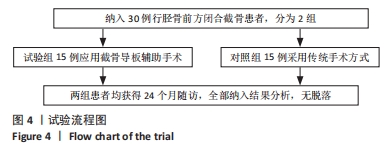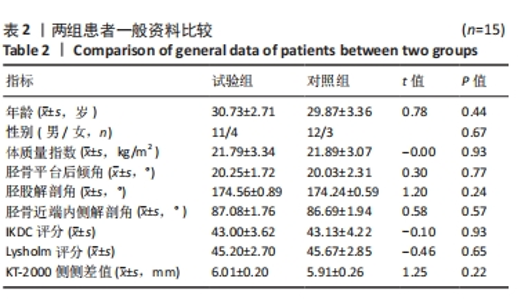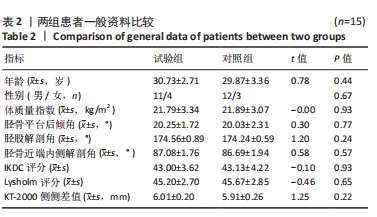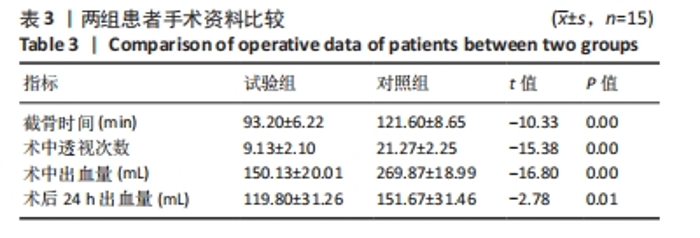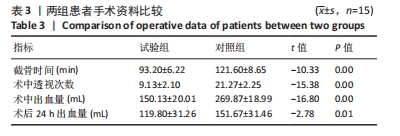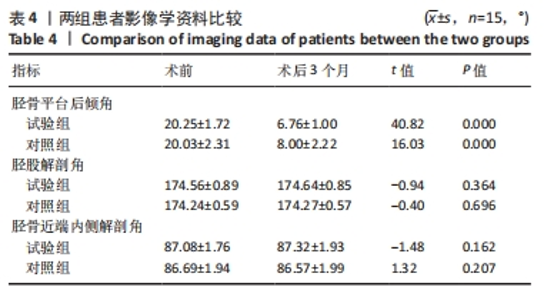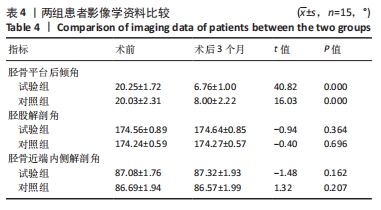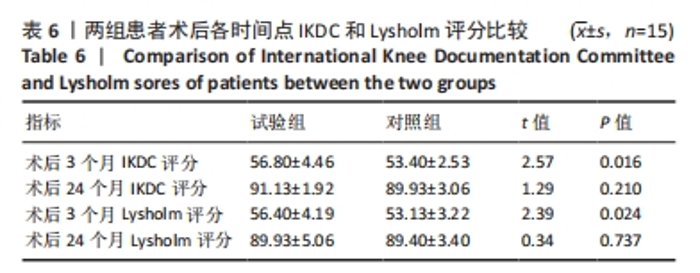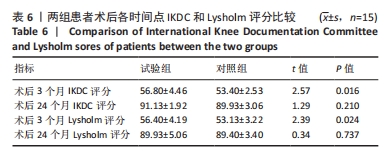Chinese Journal of Tissue Engineering Research ›› 2025, Vol. 29 ›› Issue (33): 7130-7136.doi: 10.12307/2025.861
Previous Articles Next Articles
Application of 3D printing accurate osteotomy guide combined with the revision of anterior cruciate ligament with abnormally increased posterior slope of tibial plateau
Wei Zhiheng1, 2, Guan Tianmin1, Liu Qing1, Gong Jue2, Xiang Xianxiang2
- 1School of Mechanical Engineering, Dalian Jiaotong University, Dalian 116028, Liaoning Province, China; 2Xinhua Hospital Affiliated to Dalian University, Dalian 116021, Liaoning Province, China
-
Received:2024-09-27Accepted:2024-11-28Online:2025-11-28Published:2025-04-12 -
Contact:Guan Tianmin, PhD, School of Mechanical Engineering, Dalian Jiaotong University, Dalian 116028, Liaoning Province, China -
About author:Wei Zhiheng, Doctoral candidate, Attending physician, School of Mechanical Engineering, Dalian Jiaotong University, Dalian 116028, Liaoning Province, China; Xinhua Hospital Affiliated to Dalian University, Dalian 116021, Liaoning Province, China Liu Qing, Master candidate, School of Mechanical Engineering, Dalian Jiaotong University, Dalian 116028, Liaoning Province, China
CLC Number:
Cite this article
Wei Zhiheng, Guan Tianmin, Liu Qing, Gong Jue, Xiang Xianxiang. Application of 3D printing accurate osteotomy guide combined with the revision of anterior cruciate ligament with abnormally increased posterior slope of tibial plateau[J]. Chinese Journal of Tissue Engineering Research, 2025, 29(33): 7130-7136.
share this article
Add to citation manager EndNote|Reference Manager|ProCite|BibTeX|RefWorks
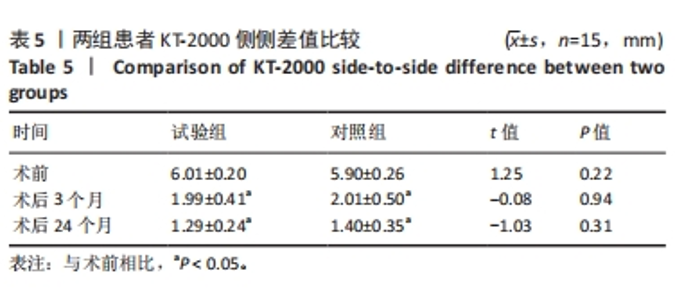
2.6 膝关节稳定性 Lachman试验:试验组术中麻醉状态下lachman试验Ⅱ度阳性9例、Ⅲ度阳性6例;术后即刻所有患者均为阴性,且为硬性止点;术后2年随访时所有患者均为阴性,且为硬性止点;对照组术中麻醉状态下lachman试验Ⅱ度阳性10例、Ⅲ度阳性5例;术后即刻所有患者均为阴性,且为硬性止点;术后2年随访时所有患者均为阴性,且为硬性止点。 Pivot-shift试验:试验组术中麻醉状态下pivot-shift试验Ⅰ度3例,Ⅱ度7例,Ⅲ度5例;术后即刻所有患者均为阴性;术后2年随访时所有患者均为阴性;对照组术中麻醉状态下pivot-shift试验Ⅰ度2例,Ⅱ度7例,Ⅲ度6例;术后即刻所有患者均为阴性;术后2年随访时所有患者均为阴性。 KT-2000侧侧差值:两组患者术后KT-2000侧侧差值与术前相比显著减少(P < 0.05);术后3,24个月,试验组术后KT-2000侧侧差值与对照组相比,差异无显著性意义(P > 0.05),见表5。"
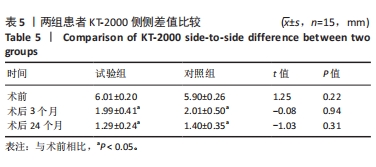
| [1] KEMLER B, COLADONATO C, PEREZ A, et al. Considerations for revision anterior cruciate ligament reconstruction: A review of the current literature. J Orthop. 2024;56:57-62. [2] MIYAMOTO A, NAKAMAE A, TSUKISAKA K, et al. Articular Cartilage Damage in the Patellofemoral Compartment at ACL Reconstruction Predicts Poor Postoperative Subjective Outcomes in Patients Age 40 and Older. J Knee Surg. 2024;37(14):925-932. [3] 冯馨元,白伦浩.保留前交叉韧带残端对膝关节稳定性的意义[J].中国组织工程研究,2019,23(4):525-531. [4] INOUE J, GIUSTO JD, DADOO S, et al. Nonanatomic femoral tunnel placement increases the risk of subsequent meniscal surgery after ACLR: Part II-Patients without recurrent ACL injury. Knee Surg Sport Tr A. 2024;32(11):2780-2789. [5] SEPPÄNEN A, KIEKARA T, SUOMALAINEN P, et al. No difference was found between double-bundle and single-bundle anterior cruciate ligament reconstructions in terms of osteoarthritis at 15-year follow-up. Knee Surg Sport Tr A. 2024;32(11):2770-2779. [6] KHOYGANI MR, ESMAEILI H. Hop distance to body height ratio outperforms limb symmetry index in predicting second anterior cruciate ligament injury. Knee Surg Sports Traumatol Arthrosc. 2024. doi: 10.1002/ksa.12405. [7] SAAD BERRETA R, VILLARREAL-ESPINOSA JB, PALLONE L, et al. Anterior Cruciate Ligament Repair Results in Similar Patient-Reported Outcome Measures as Anterior Cruciate Ligament Reconstruction: A Systematic Review of Prospective Comparative Studies. Arthroscopy. 2024:S0749-8063(24)00673-X. [8] RAHARDJA R, LOVE H, CLATWORTHY MG, et al. Validating the capture rate of revisions by the New Zealand ACL Registry: An analysis of all-cause reoperation following primary ACL reconstruction. Knee Surg Sports Traumatol Arthrosc. 2024;32(11):2790-2797. [9] LIN J, ZHANG S, XIN E, et al. Anterior cruciate ligament femoral footprint is oblong-ovate, triangular, or two-tears shaped in healthy young adults: three-dimensional MRI analysis. Knee Surg Sports Traumatol Arthrosc. 2023;31(12):5514-5523. [10] NI QK, SONG GY, ZHANG ZJ, et al. Steep posterior tibial slope and excessive anterior tibial translation are predictive risk factors of primary anterior cruciate ligament reconstruction failure: a case control study with prospectively collected data. Am J Sports Med. 2020;48(12): 2954-2961. [11] YOSHIDA R, KOGA H, NAKAMURA T, et al. Steep medial posterior tibial slope angle and ramp lesion are independent risk factors for an increase in quantitatively measured pivot shift in patients with ACL-deficient knees. J Exp Orthop. 2024;11(3):e70011. [12] BOSCO F, GIUSTRA F, GIAI VIA R, et al. Could anterior closed-wedge high tibial osteotomy be a viable option in patients with high posterior tibial slope who undergo anterior cruciate ligament reconstruction? A systematic review and meta-analysis. Eur J Orthop Surg Traumatol. 2023;33(6):2201-2214. [13] DUERR R, ORMSETH B, ADELSTEIN J, et al. Elevated Posterior Tibial Slope Is Associated With Anterior Cruciate Ligament Reconstruction Failures: A Systematic Review and Meta-analysis. Arthroscopy. 2023; 39(5):1299-1309. [14] VIVACQUA T, THOMASSEN S, WINKLER PW, et al. Closing-Wedge Posterior Tibial Slope-Reducing Osteotomy in Complex Revision ACL Reconstruction. Orthop J Sports Med. 2023;11(1):1299-1309. [15] MITSOU A, VALLIANATOS P, PISKOPAKIS N, et al. Anterior cruciate ligament reconstruction by over-the-top repair combined with popliteus tendon plasty. J Bone Joint Surg (Br). 1990;72(3): 398-404. [16] SHAMROCK, ALAN G, DUCHMAN, et al. Outcomes Following Primary Anterior Cruciate Ligament Reconstruction Using a Partial Transphyseal (Over-the-Top) Technique in Skeletally Immature Patients. Iowa Orthop J. 2022;42(1):179-186. [17] KAMEI G, NAKAMAE A, NAKATA K, et al. Comparison of clinical outcomes between anterior cruciate ligament reconstruction with over-the-top route procedure and anatomic single-bundle reconstruction in pediatric patients. Pediatr Orthop B. 2023;32(2):178-184. [18] GONERA B, BALCERZAK A, RUZIK K, et al. Identifying iliotibial band graft length and incision site may minimise the potential risk of harming adjacent structures: A novel approach for surgeon guidance. Knee Surg Sport Tr A. 2024;32(8):2032-2039. [19] ZSIDAI B, ENGLER ID, PUJOL O, et al. Over-The-Top Technique for Revision ACL Reconstruction with Achilles Allograft and Associated Lateral Extra-articular Tenodesis. Arthrosc Tech. 2022;11(9):1633-1640. [20] SAAD BERRETA R, VILLARREAL-ESPINOSA JB, PALLONE L, et al. Anterior Cruciate Ligament Repair Results in Similar Patient-Reported Outcome Measures as Anterior Cruciate Ligament Reconstruction: A Systematic Review of Prospective Comparative Studies. Arthroscopy. 2024:S0749-8063(24)00673-X. [21] ÖZBEK EA, WINKLER PW, NAZZAL EM, et al. Failure Rates and Complications After Multiple-Revision ACL Reconstruction: Comparison of the Over-the-Top and Transportal Drilling Techniques. Orthop J Sports Med. 2023;11(7):23259671231186972. [22] ZAFFAGNINI S, DAL FABBRO G, LUCIDI GA, et al. Personalised opening wedge high tibial osteotomy with patient-specific plates and instrumentation accurately controls coronal correction and posterior slope: Results from a prospective first case series. Knee. 2023;44: 89-99. [23] DAN MJ, CANCE N, PINEDA T, et al. Four to 6° Is the Target Posterior Tibial Slope After Tibial Deflection Osteotomy According to the Knee Static Anterior Tibial Translation. Arthroscopy. 2024;40(3):846-854. [24] ZHAO WC, CHEN H, LI YX, et al. The application of proximal tibial anterior closing wedge osteotomy in anterior cruciate ligament reconstruction. Asia Pac J Sports Med Arthrosc Rehabil Technol. 2024; 38:1-8. [25] KEMLER B, COLADONATO C, PEREZ A, et al. Considerations for revision anterior cruciate ligament reconstruction: A review of the current literature. J Orthop. 2024;56:57-62. [26] TAPASVI S, SHEKHAR A. Revision ACL Reconstruction: Principles and Practice. Indian J Orthop. 2021;55(2):263-275. [27] FUJITA K, SAWAGUCHI T, GOSHIMA K, et al. Influence of lateral hinge fractures on biplanar medial closing‐ wedge distal femoral osteotomy for valgus knee: a new classification of lateral hinge fracture. Arch Orthop Trauma Surg. 2023;143:1175-1183. [28] MATSUSHITA T, MORI A, WATANABE S, et al. Analysis of bone union after medial closing wedge distal femoral osteotomy using a new radiographic scoring system. Arch Orthop Trauma Surg. 2022;142(9): 2303-2312. [29] MEISTERHANS M, CALEK AK, ZINDEL C, et al. Influence of varus-producing distal femur osteotomy correction and hinge width in relation to hinge fractures: Biomechanical study on porcine femora. Knee. 2024;51:282-291. [30] ARAYA N, KOGA H, NAKAGAWA Y, et al. Risk factors for delayed bone union in opening wedge high tibial osteotomy. Jt Dis Relat Surg. 2024;35(3):546-553. [31] YAO SY, ZHANG XZ, PODDER S, et al. Enhanced reliability and time efficiency of deep learning-based posterior tibial slope measurement over manual techniques. Knee Surg Sports Traumatol Arthrosc. 2024. doi: 10.1002/ksa.12241. [32] MONTGOMERY SR JR, GARRA S, MOORE M, et al. Posterior tibial slope angle in contact versus non-contact anterior cruciate ligament injuries. Eur J Orthop Surg Traumatol. 2024;34(8):4037-4042. [33] EHMANN YJ, ESSER T, VIEIDER RP, et al. Clinical Outcomes and Long-term Survivorship After Osteochondral Autologous Transfer Combined With Valgus High Tibial Osteotomy: An Analysis After 19 Years With 56 Patients. Am J Sports Med. 2024;52(12):3004-3012. [34] GIMM G, JI H, RO DH, et al. Medial Joint Opening in the Operated Knee After Unilateral High Tibial Osteotomy: Risk of Osteoarthritis and Future Surgery in the Operated and Nonoperated Knee. Am J Sports Med. 2024;52(13):3266-3276. [35] AHREND MD, PETZOLD D, SCHUSTER P, et al. Higher conversion rate to knee arthroplasty in female patients following medial open-wedge high tibial osteotomy. Knee Surg Sports Traumatol Arthrosc. 2024;32(10):2562-2572. [36] 马驰,王宁,陈拥,等. 3D打印个体化截骨导板结合定制钢板在开放楔形胫骨高位截骨中的应用[J]. 中国组织工程研究,2025,29(9): 1863-1869. [37] PREDESCU V, GROSU AM, GHERMAN I, et al. Early experience using patient-specific instrumentation in opening wedge high tibial osteotomy. Int Orthop. 2021;45(6):1509-1515. [38] VICTOR J, PREMANATHAN A. Virtual 3D planning and patient specific surgical guides for osteotomies around the knee: a feasibility and proof-of-concept study. Bone Joint J. 2013;95:153-158. [39] RAYAN F, NANJAYAN SK, QUAH C, et al. Review of evolution of tunnel position in anterior cruciate ligament reconstruction. World J Orthop. 2015;6(2):252-262. [40] SAMITIER G, MARCANO AI, ALENTORN-GELI E, et al. Failure of anterior cruciate ligament reconstruction. Arch Bone Jt Surg. 2015;3:220-240. [41] MABROUK A, KLEY K, JACQUET C, et al. Outcomes of Slope-Reducing Proximal Tibial Osteotomy Combined With a Third Anterior Cruciate Ligament Reconstruction Procedure With a Focus on Return to Impact Sports. Am J Sports Med. 2023;51(13):3454-3463. [42] ITTHIPANICHPONG T, UPPSTROM TJ, V MENTA S, et al. Systematic Review of Clinical Outcomes After Proximal Tibia Anterior Closing-Wedge Osteotomy With ACL Reconstruction. Orthop J Sports Med. 2023;11(12):23259671231210549. |
| [1] | Ma Chi, Wang Ning, Chen Yong, Wei Zhihan, Liu Fengji, Piao Chengzhe. Application of 3D-printing patient-specific instruments combined with customized locking plate in opening wedge high tibial osteotomy [J]. Chinese Journal of Tissue Engineering Research, 2025, 29(9): 1863-1869. |
| [2] | Zhang Yu, Xu Ruian, Fang Lei, Li Longfei, Liu Shuyan, Ding Lingxue, Wang Yuexi, Guo Ziyan, Tian Feng, Xue Jiajia. Gradient artificial bone repair scaffold regulates skeletal system tissue repair and regeneration [J]. Chinese Journal of Tissue Engineering Research, 2025, 29(4): 846-855. |
| [3] | Hu Chaoran, Cen Chaode, Yang Yang, Zhou Cheng, Huang Huaxian, Yuan Honghao, Luo Qin, Cao Yongfei. 3D printing assisted minimal invasive plate osteosynthesis versus intramedullary nail for treatment of AO12-C middle-proximal humeral fractures [J]. Chinese Journal of Tissue Engineering Research, 2025, 29(33): 7116-7122. |
| [4] | Li Guoliang, Zhao Jianyong, Lyu Deliang, Su Juyue, Liu Qilin, Wang Tieqiang, Wang Xin. Improved 3D printed splint for distal radius fracture based on clinical defects: design and rapid grid-free analysis [J]. Chinese Journal of Tissue Engineering Research, 2025, 29(33): 7123-7129. |
| [5] | Zhuang Yan, Wang Xinyu, Cao Yilin, Ding Yuanxin, Wang Jiaqi, Yu Miao, Luan Chunyang, Ding Yuansheng. Three-dimensional finite element analysis of personalized orthodontic devices for 3D printed maxillary single-rooted rotated tooth [J]. Chinese Journal of Tissue Engineering Research, 2025, 29(30): 6409-6415. |
| [6] | Zhao Xiaoxuan, Liu Shuaiyi, Xing Zheng, Li Qingwen, Chu Xiaolei, Li Qi. Research hotspots and trends in application of tissue engineering in peripheral nerve injury [J]. Chinese Journal of Tissue Engineering Research, 2025, 29(30): 6591-6600. |
| [7] | Lian Zeshuang, Xu Qiang, Wang Aoting, Li Ding, Qin Jialin, Wang Junfang. Application of 3D printing technology in traumatic fractures [J]. Chinese Journal of Tissue Engineering Research, 2025, 29(27): 5883-5889. |
| [8] | Xu Jie, Jiu Jingwei, Liu Haifeng, Zhao Bin. Bio-3D printed bionic scaffold promotes healing after rotator cuff injury [J]. Chinese Journal of Tissue Engineering Research, 2025, 29(22): 4761-4770. |
| [9] | Jiang Zhixiu, Ji Yuchen, Liu Danyu, Cao Yilin, Jiang Tingting, Song Yihan, Wang Lei, Wang Xinyu. Biomechanical properties of Gyroid structured titanium bionic bone scaffolds for repairing segmental mandibular defects [J]. Chinese Journal of Tissue Engineering Research, 2025, 29(22): 4621-4628. |
| [10] | Wang Yuning, Zhu Haotian, Liu Kang, Ding Huanwen, Yan Han. Comparison of short-term therapeutic effects between digital precision total knee arthroplasty and traditional methods [J]. Chinese Journal of Tissue Engineering Research, 2025, 29(21): 4521-4528. |
| [11] | Yan Xinghua, Wang Xinyu, Liu Miao, Han Zekui, Song Yihan, Zhang Yan, Sun Zihui. Preparation and mechanical property analysis of hydrophilic Gyroid structure implant [J]. Chinese Journal of Tissue Engineering Research, 2025, 29(16): 3343-3350. |
| [12] | Cheng Weilu, Wang Zehua, Zhang Yidan, Liu Yinghui. Application and regulatory challenges of organoid technology in medical field [J]. Chinese Journal of Tissue Engineering Research, 2025, 29(1): 202-210. |
| [13] | Wang Menghan, Qi Han, Zhang Yuan, Chen Yanzhi. Three kinds of 3D printed models assisted in treatment of Robinson type II B2 clavicle fracture [J]. Chinese Journal of Tissue Engineering Research, 2024, 28(9): 1403-1408. |
| [14] | Ning Tianliang, Wang Kun, Wang Lingbiao, Han Pengfei. Finite element analysis on correction effect of varus foot orthosis based on the three-point force principle [J]. Chinese Journal of Tissue Engineering Research, 2024, 28(6): 891-899. |
| [15] | Shen Ziqing, Xia Tian, Shan Yibo, Zhu Ruijun, Wan Haoxin, Ding Hao, Pan Shu, Zhao Jun. Vascularized tracheal substitutes constructed by exosome-load hydrogel-modified 3D printed scaffolds [J]. Chinese Journal of Tissue Engineering Research, 2024, 28(5): 697-705. |
| Viewed | ||||||
|
Full text |
|
|||||
|
Abstract |
|
|||||

